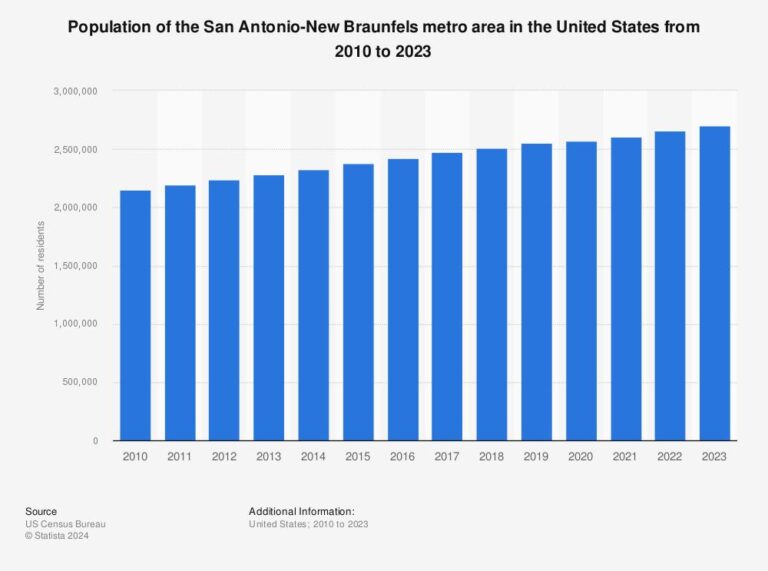San Antonio’s Population Boom: Poised to Become America’s Sixth Largest City
San Antonio’s Meteoric Rise in Urban Hierarchy
San Antonio is rapidly transforming the urban landscape of the United States, with recent U.S. Census figures indicating it may soon surpass Philadelphia to claim the position of the sixth largest city nationwide. This surge is driven by a flourishing economy, a vibrant cultural scene, and an influx of residents attracted by affordable living costs. The city’s upward trajectory in population rankings highlights Texas’s growing prominence in the national demographic shift.
Several pivotal elements underpin San Antonio’s growth:
- Steady expansion in sectors such as technology, healthcare, and advanced manufacturing
- Focused enhancements in transportation infrastructure and public transit systems
- Competitive housing prices drawing in young professionals and families
- A rich cultural environment that boosts overall quality of life
| City | Projected Population 2024 | Population Growth Rate (2020-2024) |
|---|---|---|
| San Antonio, TX | 1,580,000 | 7.1% |
| Philadelphia, PA | 1,570,000 | 0.3% |
Unpacking the Demographic Forces Behind San Antonio’s Expansion
The rapid population increase in San Antonio is fueled by a combination of demographic trends that distinguish it from many other major U.S. cities. Notably, the city boasts a younger median age—33 years—compared to the national average, making it a magnet for families and early-career professionals. This youthful demographic is bolstered by both natural population growth and significant domestic migration, particularly from higher-cost urban centers.
Moreover, San Antonio’s diverse cultural composition, with a Hispanic community representing approximately 64% of the population, enriches the city’s social fabric and economic vitality. This demographic diversity fosters a dynamic environment conducive to innovation and community development.
Additional demographic contributors include:
- Strong domestic migration trends, with an annual net gain of around 15,000 residents relocating from more expensive metropolitan areas
- Birth rates exceeding many national averages, supporting natural population growth
- Economic growth fueling job creation in healthcare, technology, and logistics sectors
| Demographic Factor | Effect on Growth | Relevant Statistic |
|---|---|---|
| Youthful Population | Enhances long-term growth potential | Median age: 33 years |
| Economic Expansion | Attracts workforce and stimulates job market | Annual employment growth: 3.5% |
| Hispanic Community Growth | Drives cultural and economic enrichment | Population share: 64% |
| Domestic Migration | Increases population from high-cost cities | Net migration: +15,000 per year |
Economic Consequences for San Antonio and Philadelphia Amidst Changing Rankings
San Antonio’s burgeoning population is set to reshape its economic landscape and that of the surrounding region. As it nears the milestone of becoming the sixth largest U.S. city, the demand for housing, infrastructure, and public services is expected to surge. This growth will likely accelerate expansion in key industries such as technology, healthcare, and manufacturing, attracting a more diverse and skilled workforce and enhancing the city’s national economic stature.
Conversely, Philadelphia faces the challenge of maintaining its economic competitiveness as it potentially cedes its ranking. While its core industries—finance, education, and healthcare—remain robust, Philadelphia may need to intensify efforts to foster innovation, entrepreneurship, and workforce development. Revitalization projects and skill enhancement programs are anticipated to be central to sustaining the city’s economic health.
| Economic Indicator | San Antonio | Philadelphia |
|---|---|---|
| Recent Population Growth Rate | 2.1% | 0.5% |
| Unemployment Rate | 4.2% | 5.8% |
| Median Household Income | $57,523 | $47,474 |
| Dominant Growth Sectors |
|
|
Urban Planning Strategies to Support Sustainable Growth in San Antonio
As San Antonio prepares to join the ranks of the nation’s largest cities, city planners and policymakers face the critical task of managing growth sustainably. Expanding and integrating multimodal public transportation systems will be essential to alleviate traffic congestion and improve connectivity between rapidly developing neighborhoods. Additionally, enhancing pedestrian and bicycle infrastructure can promote environmentally friendly commuting and healthier lifestyles.
To support the swelling population, investments in resilient infrastructure are paramount. This includes modernizing water management to mitigate risks from droughts and floods, and upgrading energy grids to accommodate emerging smart city technologies. Equally important is the implementation of inclusive zoning policies that encourage a variety of affordable housing options, ensuring equitable growth across all income levels.
- Development of integrated, multimodal transit networks
- Enhancement of climate-resilient utilities and public services
- Creation of mixed-use neighborhoods to shorten commute times
- Promotion of affordable housing and improved community access
| Focus Area | Expected Outcome |
|---|---|
| Expansion of Public Transit | 30% decrease in peak-hour traffic congestion |
| Upgrades to Water Infrastructure | 40% improvement in drought resilience |
| Affordable Housing Programs | Accommodation for 15,000 additional residents |
| Implementation of Smart Energy Grids | 30% reduction in power outages |
Conclusion: San Antonio’s Emerging Role in America’s Urban Future
San Antonio’s impending rise to become the sixth largest city in the United States marks a pivotal moment in the nation’s urban evolution. This demographic milestone not only highlights the city’s expanding economic and cultural influence but also underscores the necessity for forward-thinking infrastructure and housing policies. As the city continues to attract a diverse and growing population, stakeholders must collaborate to ensure that development is inclusive, sustainable, and enhances the quality of life for all residents. The unfolding census data will be closely watched as a barometer of San Antonio’s ongoing transformation and its broader impact on the American urban landscape.




